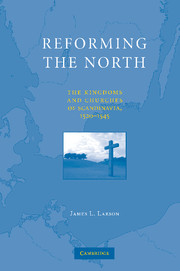Book contents
- Frontmatter
- Contents
- Acknowledgments
- Abbreviations
- Maps
- REFORMING THE NORTH
- Introduction
- 1 The North
- Part I Lord of the Northern World, 1513–1523
- Part II Successors, 1523–1533
- Part III Civil War, 1533–1536
- 13 A Republic of Nobles
- 14 Reactions
- 15 The War of All Against All
- 16 The Fall of Copenhagen
- Part IV The Settlement, 1536–1545
- 21 Conclusion
- Bibliography
- Index
15 - The War of All Against All
Published online by Cambridge University Press: 26 February 2010
- Frontmatter
- Contents
- Acknowledgments
- Abbreviations
- Maps
- REFORMING THE NORTH
- Introduction
- 1 The North
- Part I Lord of the Northern World, 1513–1523
- Part II Successors, 1523–1533
- Part III Civil War, 1533–1536
- 13 A Republic of Nobles
- 14 Reactions
- 15 The War of All Against All
- 16 The Fall of Copenhagen
- Part IV The Settlement, 1536–1545
- 21 Conclusion
- Bibliography
- Index
Summary
In January 1535, Count Christoffer's hold on Denmark was far more tenuous than it had been only a few months earlier. Johann Rantzau held the peninsula of Jylland. Skaane, Halland, and Blekinge on the northern peninsula were held by the nobles of Skaane and a Swedish force on behalf of the duke of Holstein. Count Christoffer had appointed Gustaf Trolle, the exiled archbishop of Sweden, stateholder on Fyn and bishop of Odense. On Sjælland Count Christoffer shared power with burghers, Lübeckers, and Duke Albrecht's stateholder, Count Johann zur Hoya. Copenhagen and Malmø were ruled by their burghers as free cities. Lübeck held Falster with the fortress of Nykøbing, Helsingør with the fortress of Krogen, and half the Öresund tolls. Rostock held Aalholm and parts of Lolland.
And while Count Christoffer's foes concerted future operations by land and sea, dissension prevented the factions in Copenhagen from taking countermeasures.
Duke Christian sent envoys to Sweden by way of Baahus on the southeast coast of Norway. They were to warn Gustaf Vasa of Lübeck's plans for Sweden, and to request pay and transport for a regiment of Knechts which would cross the Kattegat from north Jylland to Skaane. The duke asked the king to join the fleet provided by Preussen and enter the waters of eastern Denmark while his own forces crossed to the larger islands from the west.
- Type
- Chapter
- Information
- Reforming the NorthThe Kingdoms and Churches of Scandinavia, 1520–1545, pp. 339 - 365Publisher: Cambridge University PressPrint publication year: 2010



